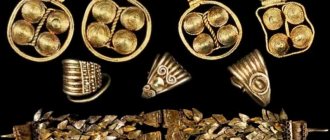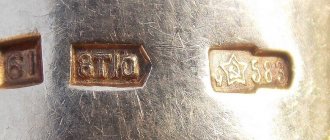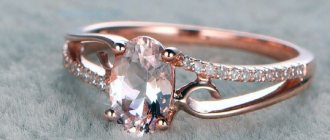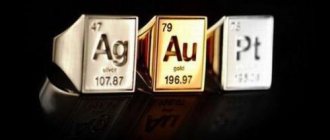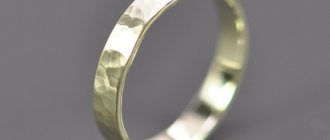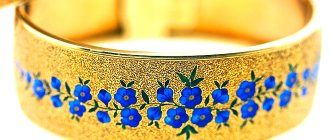Incredible facts
Gold is one of the most mysterious substances that is associated with great value. Even during the Olympic Games, the winner's medal is gold.
So why did gold become the most valuable of all metals?
Gold is not the rarest element and does not react with many other elements. It is not radioactive or poisonous, and is yellow in color.
Here are some more fun facts about gold that you may not already know.
Ancient times
The history of gold, the history of the precious metal, began in ancient times, more than 5,000 years ago. The ancient inhabitants of Egypt already from that time understood about its strength and power. The solar metal was revered in the same way as the gods and legends were made about it. And fashionistas dreamed of having gold jewelry, because it was believed that they brought happiness and good luck. At a certain period, only the highest ranks of society could afford gold, and ordinary people were strictly forbidden to wear jewelry.
In ancient times, people made various jewelry from gold, mainly they depicted the animal and plant world, and the minting of the first gold coins from gold began. Every ancient country dreamed of having the sunny, revered metal, and very often blood was shed because of gold. Warriors for metal captured more and more countries, and it passed from one state to another until Rome collapsed. After this, all reserves of the gold metal were scattered throughout the world.
Ancient Egypt - the first mass mining of gold
Obviously, man began the first gold mining about six thousand years ago. It was mined in the form of nuggets and flakes from the gravel beds of rivers and streams in Asia Minor (the territory of modern Turkey) and Central Asia (wholly or partially the territory of the modern Republic of Tuva, Uzbekistan, Turkmenistan, Tajikistan, Kyrgyzstan and Kazakhstan).
Around this time or slightly later, the Egyptians began to extract gold from the sands along the Nile in Egypt and Nubia (modern Sudan) and on the plateau east of the Nile along the Red Sea. In the plateau deposits, gold was first recovered from surface weathered rocks and then from shafts and tunnels that sometimes went up to 100 meters below the surface.
Quite interesting is the fact that in the 20th century these territories were thoroughly explored by modern geologists. It turned out that the ancient Egyptians mined almost all the gold there. Not a single deposit remained untouched by the ancient gold miners, and all significant deposits were completely worked out.
The Egyptians probably also mined gold in other places in Africa and the Arabian Peninsula.
In any case, Egypt was the source of most of the gold in the ancient Mediterranean until the rise of Greece.
Indian gold
Yellow metal actually played a big role in the life of ancient peoples. But in addition to power and wealth, it also brought destruction. For example, in the 16th century, Indian territories were captured by a local ruler. The Incas paid the Spaniards in gold for him for almost 3 months, but they were never able to save him.
The glitter of gold blinded the conquerors, and they moved inland to search for new golden treasures. The capture of the main city of the Incas took place almost without a fight; the capture and death of the leader undermined the spirit of the Incas. Eyewitnesses claim that the capital was almost entirely made of solar metal; the cladding of the buildings literally blinded with its golden shine.
To this day, scientists and travelers around the world are searching for this lost city. Many of them want to feel the power and strength of gold, replenish their wealth, and some just want to touch the legend and spirit of that time.
stories about gold in the world, almost all of them are based on real events of ancient times.
Scientific facts about gold
14. The chemical symbol for gold is Au, which comes from the Latin word “aurum,” or “blazing dawn.”
15. A noble metal, gold, does not rust, does not tarnish, and does not form an oxide film on its surface when in contact with air.
16. Because this precious metal is virtually indestructible, it is usually melted, refined, and reused. This means your gold ring could have particles from Ancient Rome on it!
17. Today's world standard of 200 mg metric carats was established in 1907, and the United States adopted this measurement method in 1913. Previously, standards ranged from 187 mg to 215.99 mg.
18. Of the 92 naturally occurring elements, gold ranks 58th in rarity. The rarest elements on Earth are platinum-based metals such as osmium, rhodium and iridium.
19. Pure gold is so soft that it can be sculpted by hand.
20. The melting point of gold is 1064 °C.
21. Almost all of the Earth's gold was obtained from meteorites 200 million years ago.
22. Some rheumatoid arthritis patients receive injections of liquid gold to reduce inflammation.
23. During earthquakes, water inside faults can break down and evaporate, forming gold.
Golden fever
Currently, the world reserve of this precious metal is slightly more than 160,000 tons. Miners during the Gold Rush made a major contribution to this reserve. The first fever arose in the 17th century in Brazil. About a million people became infected with the gold mining disease. There were a huge number of people at the mining sites, among them were not only ordinary people who wanted to get rich, but also criminals engaged in ordinary theft. It was especially dangerous to be at the sales sites, because you could not only sell your precious loot, but also lose your life for it.
The pursuit of wealth in the form of gold captured many countries, and the fever did not spare our country. At the beginning of the 19th century, miners discovered gold deposits in Siberia, where people flocked for solar metal, risking their lives.
2. Gold ore has been discovered on all continents of the Earth, although it remains a rare metal.
3. Gold was one of the first metals discovered by man.
4. Gold is mentioned at least 400 times in the Bible. Among other things, there is an instruction from God to cover the furniture in the tabernacle with “pure gold.” This metal is also mentioned as one of the gifts of the Magi.
5. Even 1200 years ago, the Egyptians separated gold grains from sand from the seabed using unshorn sheepskin. This is probably why the famous myth of the “Golden Fleece” arose.
6. It is believed that about 80% of the total gold reserves of our planet are still located deep within the Earth.
7. Gold is the most famous metal in the world, serving people for thousands of years as a measure of material wealth and a standard of values.
8.Gold's unique status among other metals is due to its intrinsic beauty, rarity and physical properties.
9. Gold is one of the foundations of the modern world economy because this metal does not rust, is widely used in industry and is rare enough to always have a high price.
10. From the discovery of gold to the present day, people have mined about 161,000 tons of this metal. The market value of all this wealth is now $9-10 trillion.
GOLD DEPOSIT. WITWATERSRANDA, South Africa
11. Three or four Olympic swimming pools can hold all the gold mined in the entire history of mankind. Moreover, almost half of this gold was mined from one place - the Witwatersrand, in South Africa.
12.More steel is smelted in the world every hour than the amount of gold mined in all of human history.
13. It is known that 75% of the weight of all the gold that people use today was mined only after 1910, i.e., before this year, gold mining was negligible.
14. Previously, in ancient times, Nubia was recognized as the largest gold miner, this is evidenced by facts taken from the pages of the Turin papyrus.
15. There, slaves mined gold from the mud, searched for gold nuggets by hand, while experiencing wild suffering.
16. And the jewelers who made items from this gold for noble people were held in very high esteem and were practically considered saints.
17.Only about 10% of all world gold mining meets the needs of industry, the rest goes to the production of jewelry and gold bars.
18. Absolutely pure gold has a very soft and malleable state, so its shape can be changed by hand.
19. The purity of gold is determined in carats. The term "carat" comes from carob seeds, which are used in Middle Eastern countries for weighing. Carats are leguminous fruits, each carob pod weighs 1/5 g (200 mg).
20. The name “troy ounce” comes from the city of Troyes, which is located in France. It was the first to create a system of scales used for precious metals and stones. One such ounce is equal to the weight of 480 carat grains, each grain weighing exactly 64.79892 mg.
21. In the ranking of countries for gold production, China is in first place, then Russia. Next come South Africa, Australia and the USA.
22. The carat weight of gold can be 10, 12, 14, 18, 22 or 24. The higher this number, the higher the quality of the gold. “Fine gold” is considered to have a minimum weight of 10 carats. “The purest gold” is 24 carats, but it also contains a small amount of copper.
23. Pure gold is 999 fine. Because it is too soft to be scratched with a fingernail, other metals such as copper and silver are added to it. The amount of pure gold in the alloy is determined by the sample. In the 585 alloy there is 0.585 mg of gold per 1 g.
24. Gold is a very flexible metal. It can be used to make sewing threads. One ounce of gold (28.35 grams) can be stretched over 80 kilometers.
25.The melting point of gold is 1064.43 degrees Celsius. This metal conducts heat and electricity perfectly and never rusts.
26. Scientists believe that about 10 billion tons of gold are contained in the waters of the world’s oceans and on the ocean floor, but methods that would make its extraction in such conditions possible and economically justified do not yet exist.
27. Decorative gold found in Bulgaria dates back to 4000 BC and the Stone Age era.
28.Back in the 7th century BC. Italian dentists used gold wire to insert teeth.
ETRUSCAN GOLD
29. In ancient Egypt, gold was considered skin, that is, the flesh of the Gods. In particular, the Sun God Ra. For this reason, the precious metal was only available to the pharaohs, their family members and priests. The chambers in which the king’s sarcophagus was located were called the “house of gold.”
30.The ancient Greeks believed that gold was a dense combination of water and sunlight.
31.The Incas called gold “Tears of the Sun.” It was believed that this metal was a gift to people from the Sun God.
32. In 560 BC. The Lydians issued the world's first gold coin. True, it was not made of pure gold, but of electrum - an alloy of gold and silver. Around the world, the use of gold coins began after the lands of the Lydians were captured by the Persians.
GOLDEN DUCAT
33. The gold ducat, introduced into circulation in Venice in 1284, remained the most popular coin in the world for 500 years.
34. Ducat means “prince” in Latin. This coin was used during Shakespeare's Romeo and Juliet, and is also mentioned in the play The Merchant of Venice.
35.Rapper Ice Cube sings about golden ducats in one of his compositions, and they are also mentioned in the science fiction film “Babylon 5” as about the Centauri money race.
GOLD RUSH IN AMERICA
36. The first officially recorded gold nugget was mined in the United States of America, in Cabarru, North Carolina. He weighed 17 pounds (7.7 kilograms).
37. It was North Carolina that became the birthplace of the “gold rush”. After a second nugget was discovered here in 1803.
GOLD ORE
38. In 1940, Hungarian chemist Gyorgy de Hevesy dissolved the gold Nobel medals of German physicists Max von Laue and James Frank in aqua regia to prevent the Nazis from confiscating the precious metal. After the war the medals were restored.
39. The ransom for the Inca ruler Atavallpa, paid to the Spanish conquistadors by his subjects, consisted of 700 gold and 300 silver plates taken from the walls, floor and ceiling of the local temple. This is the largest military ransom in the entire history of human civil strife.
40. Some tribes in India believed that if you eat gold, it will give you the ability to levitate.
41. The average adult's body contains about 0.2 mg of gold.
42. Gold does not cause allergies, so even people with extremely sensitive skin can wear gold jewelry.
43. Gold is a very effective remedy that is used in the treatment of rheumatoid arthritis, this was proven by medical experiments that were carried out at the beginning of the 20th century.
44. In the 14th century, crushed emeralds were added to molten gold and the mixture was used as a cure for the bubonic plague.
45. The weight of one of the largest gold nuggets was 72 kg, its dimensions were 31x63.5 cm. The “treasure” was discovered by John and Richard Deason in Australia on February 5, 1869. The nugget was given the name “Hello, Stranger.” It is noteworthy that the golden “stone” was located at a depth of five centimeters from the surface of the earth.
FEDERAL RESERVE BANK, NEW YORK
46. The largest reserve of gold in the world is in the Federal Reserve Bank vault of New York. It contains 25% of the world's gold reserves (540,000 gold bars). Most are owned by foreign governments.
47. The United States has the most gold in reserves - about 8,133.5 tons, Germany is in second place - 3,371 tons, Italy is in third place with reserves - 2,451.8 tons. Russia is in 5th place in this ranking.
GOLD MARKET IN DUBAI
48. Our reserves are also gradually growing and currently amount to about 1950 tons. Russia occupies a leading position in the world in the production of placer gold. 48. The world's first gold vending machine was opened in May 2010 and is located in a very luxurious hotel in Abu Dhabi. The vending machine itself is also plated with 24 carat gold.
49. Scientists believe that gold and other metals heavier than iron arose as a result of the destruction of neutron stars.
50. Of course, there are more expensive metals and minerals, but gold has been used for centuries as the most powerful financial argument. It is valued everywhere, in any country, at any time.
GOLDEN NUGGET
photo from the Internet
In industry
The special properties of the metal have given it special significance in industry. It is used:
- in the transport industry;
- in energy;
- in the chemical industry;
- in telecommunications;
- in nanotechnology;
- aviation;
- in the space industry.
For medicinal purposes, gold is also of great importance. It is used for dental work, for rejuvenation and for the treatment of certain diseases, such as:
- colds;
- heart disease;
- diseases of the nervous system;
- development of atherosclerosis.
The rise of gold mining in the Roman Empire
About a century after the Second Punic War (218 – 201 BC), the Romans began to exploit gold and silver deposits in Spain that had previously belonged to Carthage. They improved underground construction techniques and mining methods, developed more efficient ways to pump and manage groundwater, and improved sluices. The Romans also invented and used a hydromonitor - a high-pressure water jet, which was used to break up dense gold-bearing rocks of the terraces. Hydraulic monitors are widely used in gold mining today.
To mine gold in Spain, the Romans used arrugia - complex mining operations. To build an arrugia, Roman geologists looked for a suitable piece of land with gold-bearing rock, usually a hill. Next, slaves dug parallel tunnels under its surface. A dam was built above the hill, where water was diverted from the nearest river or several rivers. Below, water outlets were built - agoge, the bottom of which was covered with bundles of gorse (thorny bush). At some point, the tunnels under the hill collapsed. Then the sluices were opened and within a few hours the water completely washed out and crushed the huge mass of rock and carried it away along the outlets. The contents of the agoge were thoroughly washed. Bundles of gorse with particles of gold deposited on them were carefully collected and burned, obtaining pure gold. In this way, a huge amount of gold was mined for that time.
Also, the Romans used advanced smelting technologies that allowed them to extract gold from complex sulfide ores.
By the beginning of the Christian era (4th century), gold production in the Roman Empire (including Asia Minor, Central Europe, France, Spain and Thrace) was 8 tons per year.
With the exception of free gold miners in the Southern Urals, Central Asian countries and some hired workers in the Roman era, most workers in the ancient world were prisoners of war, criminals and slaves. They were ruthlessly exploited and almost literally “worked to death.” Slave labor was very cheap, so the efficiency of gold mining was low. Often, less than 1 g of pure gold per ton of rock was mined from gold-quartz deposits, although the Romans were able to extract up to 15 g of gold per ton of rock from sulfide and tellurium-bearing deposits.
Jewelry industry
Gold jewelry has been made for more than 5 thousand years. The history of gold and gold jewelry walk together all the time.
Jewelry still has a certain value. Over time, manufacturing methods have changed and jewelry made from that metal has changed slightly.
Modern jewelry has become more aesthetically pleasing, but it also represents wealth and a certain status. The range of jewelry today is very large, almost anyone can choose the thing that they like. Only now jewelers no longer make them from the purest material; modern gold jewelry consists of alloys.
Alexander the Great and the gold of Ancient Greece
Despite the fact that the Greeks themselves mined gold in Macedonia and Western Thrace, it was still quite scarce until 331 BC. Alexander the Great did not conquer the Persian Empire. In the capital of Persia, the city of Susa, the royal treasury was seized. More than 300 tons of gold were transported to Greece. Alexander's subsequent conquests also brought Greece a lot of gold.
In their own gold developments, the Greeks improved methods of exploration of deposits and methods of supplying water flows to ensure the washing of gold-bearing rocks. They used heating and rapid cooling technology to break down hard ores and rocks.
Exchanges
Gold can bring a lot of money at the moment. Many people make fortunes from the difference from buying and selling precious metals. In the modern world, this can be done without even holding it in your hands. Online exchanges give any broker the opportunity to buy and sell this metal remotely. Using long-term charts, you can study what the history of the gold price was at one time or another. And we will see that in the long term, investing in gold has always been profitable. Read more about investing in gold in this section.
Facts about Fort Knox
31. As of the end of March 2021, Fort Knox contained more than 4,500 metric tons of gold.
32. Fort Knox contains about 50% of the gold reserves of the United States.
33. Fort Knox is believed to contain about 2% of the world's gold reserves.
34. Fort Knox was never sacked. In fact, no one has even attempted such an operation. With 30,000 troops, a surrounding minefield, Predator drones conducting routine surveillance, and 20-ton vault doors, this is impossible.
But why do people value gold so much?
Sigmund Freud believed that “our fascination with gold is associated with the erotic fantasies of early childhood.” However, there is a more rational explanation.
Even in ancient times, the pragmatic Egyptians noticed that it had unique physical characteristics. And the additional value of this metal was given by aesthetic features and its shortage that existed at that time.
Unique properties of gold
Gold is called a “noble” metal because it does not oxidize under normal conditions. The tradition of calling it that came from alchemy. Its chemical symbol Au comes from the Latin word "aurum", which means "Aurora" or "dawn".
In its pure form, the metal has a soft shine and a yellow tint. But impurities of other metals create different color shades: from silver-white to green and even red-orange. Pure gold is relatively soft and bends easily. This is the most flexible and ductile metal.
It is believed that this is the first precious metal that people began to use in their activities. Since the Stone Age, aurum has evolved from a material for weapons and jewelry to a universal measure of value. And the reason for this is precisely its properties:
- non-oxidation;
- flexibility and ductility;
- ductility;
- attractive appearance.
The density of this metal in its pure form is 19.3 g/cm³. For comparison: mercury has 14.0 g/cm³ and lead has 11.4 g/cm³. Impure gold, and this is exactly what it is in deposits, has a density of 16 to 18. Taking these indicators into account allows you to separate gold from clay, silt, sand and gravel.
The popularity of gold is explained by its universal physical and chemical properties. Thus, rarity, difficulty of extraction and convenient chemical properties contributed to the fact that this particular precious metal has gained such popularity.
And for many centuries now, humanity has not been able to find another similar instrument that is just as well suited for creating reserves and investments.
Gold and its reserves are the main element of the economy of most countries.
Gold in the 15th-19th centuries
Over time, people began to discover many gold deposits. In 1471 - in Mexico, Ghana and Chile. In 1823 - in the United States and Canada. Later - in Australia and South Africa.
Gradually, this metal was recognized as a monetary equivalent in all countries. And the gold industry began to flourish. Gold began its history in Russia only in the 18th century.
It is believed that the Demidovs were among the first to mine it - since 1726. Around the same time, work was carried out in the Altai mines and a little later in Karelia.
And in 1745 the metal was found in the Urals region. One of the schismatics, Erofei Markov, found an unusual stone on the road and reported it to the Office of the main Yekaterinburg plant. According to his descriptions, it was a small light stone, reminiscent of crystal. They dug up the ground in this place and found several more of the same kind. This story of the discovery of gold became the impetus for the further development of this industry.
A gold mine, called Primordial, was created at this place. Subsequently, many other nuggets were found here, which led to the discovery of even more mines, later called the Berezovsky group.
During the first ten years, more than 6,000 kilograms of this precious metal were mined from these deposits. True, this work turned out to be exhausting. The working conditions were so difficult that all gold mining work was considered hard labor.
Afterwards, many other sources of precious metals were discovered in the Ural territories. It is interesting that active mining of placer gold began in Russia.
At the end of the 19th century, deposits were found in the Far East. And since then, Russia has been one of the largest gold miners on the world market.
Why is metal noble?
Gold is one of the noble metals. This group also includes silver, platinum, rhodium, ruthenium, iridium, palladium and ismium. Metals are very reluctant to react with any elements and at ordinary temperatures are practically not susceptible to chemical influences.
You might be interested: “Drizzle” is about unpleasant but solvable everyday problems
Gold does not oxidize under the influence of oxygen and does not dissolve in water. Its state can be changed only in a special mixture of nitrous and hydrochloric acids. These interesting properties of gold allow it to retain its original shine, color and structure. For such “persistence” it received the title of the highest, noble metal.
